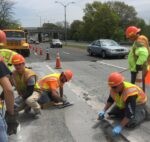
In-Place Cost
SO, YOU WANT TO SAVE TIME, MONEY, AND REPAIR MORE?
by Brian Mintz
General Manager – Phoscrete
Because state and local agency contracts are typically awarded to the lowest bidder, all too often, the choice for concrete repair material on a project is decided based on lowest cost per cubic foot. This seems quite logical and a simple calculation for a purchasing agent, made easier by choosing the cheapest product off the states’ approved product list (APL/QPL).
However, contractors should consider the following to maximize profitability on a job. The same holds true for maintenance forces who self-perform concrete repairs.
In-Place Cost is different from Material Cost. When the last cone is lifted off the roadway and the lane is re-opened to traffic, you will have incurred several costs, including:
- Traffic control
- Labor
- Materials
On interstates and major metropolitan areas, the cost of lane closure (traffic control) is often your biggest expense. And if you don’t get the repair 100% completed, you must come back out to finish the job, as much as doubling the cost of traffic control and labor.

Once a lane is closed to traffic, Site preparation is the most time-consuming task in the concrete repair process, or at least it should be. If you’re spending too much time waiting for finished concrete to set, then you are limited on the total area of repairs you can demo and complete in one shift. That may mean an additional lane closure (see above).
If the concrete repair material you chose based on price requires application of a primer (including time to dry), sandblasting, or curing compounds, factor in that additional time and labor to your In-Place Cost.
If the process for preparing your repair material requires extended mixing when adding all the different components, it will take longer to place and finish the concrete material, again limiting how much work you can complete on the shift.
If cleanup is difficult, add the time to clean your tools, and work boots (or the cost to replace them).
Phoscrete concrete repair materials are not the cheapest product you can buy, but they are often the Lowest In-Place Cost. Here’s why:
- Phoscrete mixes, finishes, and sets fast. Each mix takes just one minute. As soon as 30 minutes after your final pour, Phoscrete achieves final set and is traffic ready. This means you can complete more site preparation/demolition and repair more concrete in a single shift.
- When you’re repairing/installing expansion joints, Phoscrete does not bond to the foam board used to form up the joint. Simply pop it out once the nosing is set, and install the joint seal (epoxy, silicone) quick and easy. An expansion joint can be completely installed in one lane closure.
- No primers, sandblasting, or curing compounds required means less time required for site preparation.
- Your tools, buckets, boots, and clothes all clean up easily with water.
Most important, Phoscrete bonds strong and lasts long. When concrete repairs fail, you must return and fix the same area all over again, requiring more traffic control, labor, demolition, and material.
When you consider all these factors, using a high-quality, high-performance repair material like Phoscrete allows you to repair more faster, saving you both time and money.
